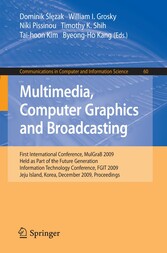Suchen und Finden
Service
Multimedia, Computer Graphics and Broadcasting - First International Conference, MulGraB 2009, Helad as Part of the Furture Generation Information Technology Conference, FGIT 2009, Jeju Island, Korea, December 10-12, 2009, Proceedings (Communications
Dominik Slezak, William I. Grosky, Niki Pissinou, Timothy K. Shih, Tai-hoon Kim, Byeong-Ho Kang (Eds
Verlag Springer-Verlag, 2009
ISBN 9783642105128 , 102 Seiten
Format PDF
Kopierschutz Wasserzeichen
"Memory Management of Multimedia Services in Smart Homes (S. 46-47)
Abstract. Nowadays there is a wide spectrum of applications that run in smart home environments. Consequently, home gateway, which is a central component in the smart home, must manage many applications despite limited memory resources. OSGi is a middleware standard for home gateways. OSGi models services as dependent components. Moreover, these applications might differ in their importance. Services collaborate and complement each other to achieve the required results.
This paper addresses the following problem: given a home gateway that hosts several applications with different priorities and arbitrary dependencies among them. When the gateway runs out of memory, which application or service will be stopped or kicked out of memory to start a new service. Note that stopping a given service means that all the services that depend on it will be stopped too.
Because of the service dependencies, traditional memory management techniques, in the operating system literatures might not be efficient. Our goal is to stop the least important and the least number of services. The paper presents a novel algorithm for home gateway memory management. The proposed algorithm takes into consideration the priority of the application and dependencies between different services, in addition to the amount of memory occupied by each service. We implement the proposed algorithm and performed many experiments to evaluate its performance and execution time. The proposed algorithm is implemented as a part of the OSGi framework (Open Service Gateway initiative). We used best fit and worst fit as yardstick to show the effectiveness of the proposed algorithm.
1 Introduction
Broadband connections like Fiber to Home allowed the Internet to be used not only for connecting computers, laptops, and PDAs but also for home appliances like TV, refrigerators, washers [20]. Remote diagnosis and remote configuration of home appliances are some of the most attractive applications. In the entertainment field there are several interesting applications, for example, users can download movies on demand and an Electronic Programming Guide (EPG).
Power companies are also keeping an eye on home networking because it will allow them to provide valueadded services such as energy management, telemetric (remote measurement), and better power balance that reduces the likelihood of blackout. Consumer electronics companies started to design Internet-enabled products. Merloni Elettrodomestici, an Italy-based company announced their Internet washer Margherita2000 that can be connected to the Internet through which it can be configured, operated, or even diagnosed for malfunctions.
LG presented the GR-D267DTU Internet Refrigerator which contains a server which controls the communication to the other three appliances; it also has full internet capabilities. Matsushita Electric showed during a recent Consumer Electronic exhibition showed an Internet-enabled microwave, which can download cooking recipes and heating instructions from the Internet. There are several initiatives to define the specification for network protocols and API suitable for home applications, like UPnP [11], Jini [9] [10] , to name a few. It is expected that multiple home network protocols will coexist in the home and interoperate through the home gateway.
The gateway acts also as a single point of connection between the home and outside world. OSGi [14] [15] (Open service Gateway initiative) is a consortium of companies that are working to define common specifications for the home gateway. According to OSGi model, the gateway can host services to control and operate home appliances. In the OSGi model, services are implemented in software bundles (or modules) that can be downloaded from the Internet and executed in the gateway [6]. For example, HTTP service is implemented in a bundle while security application would be implemented in another bundle. Bundles communicate and collaborate with each other through OSGi middleware and thus, bundles depend on each other."



